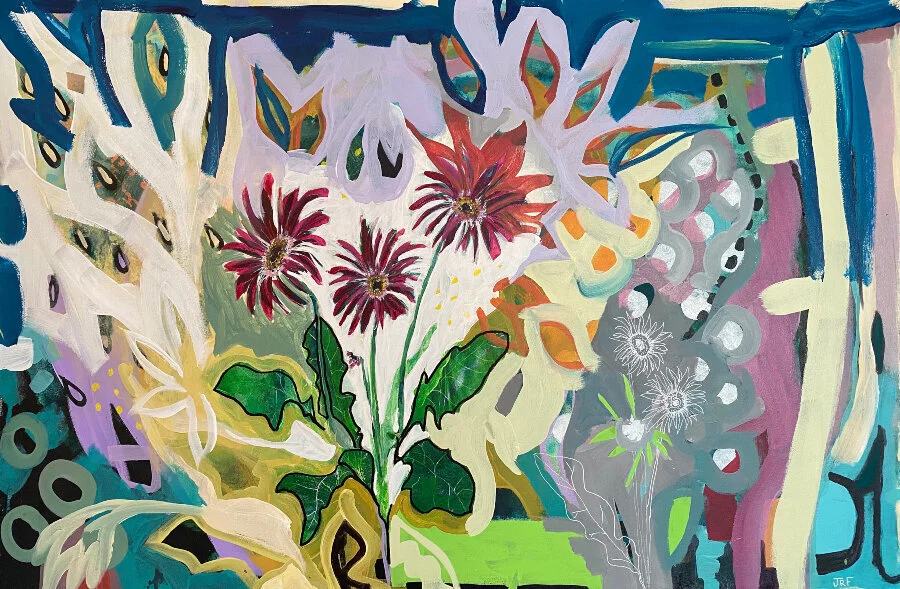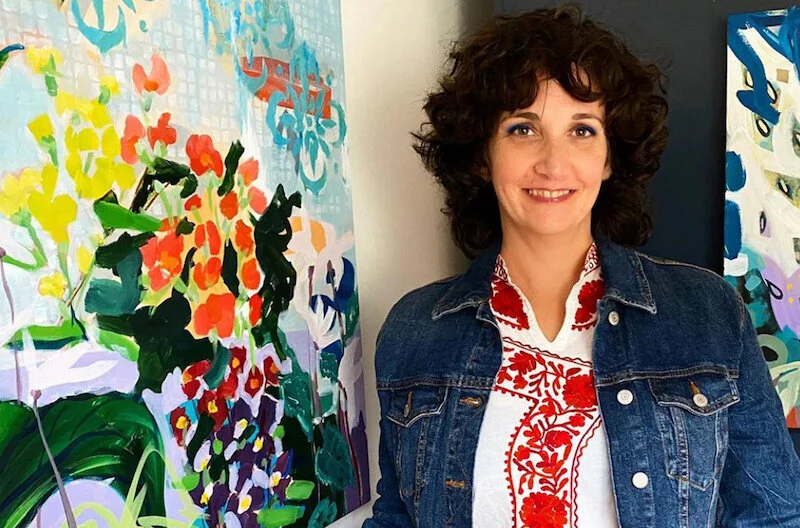Marketing Your Art, Made Easy
* Updated December 2024
You’ve already made your art. Now it’s time to sell it!
Marketing is all about recognizing the power in your community. Here’s how to access it!
The best way to market your art is to be an authentic, enthusiastic member of your community.
Take it from Superfine Art Fair exhibitor Jessica Ruth Freedman.
The Vancouver, British Columbia based artist is far more of an art marketing maven than she’ll admit to being. In addition to exhibiting her work at our debut Superfine San Francisco Art Fair earlier in February 2020, Jessica has exhibited in our online e-fairs as well. Through Superfine, Jessica is able to have her finger on the pulse of the art scene in the Pacific Northwest in more ways than one.
Jessica Ruth Freedman, “Ants at a Picnic” acrylic on canvas, 24 x 36 x 1.5in.
How Jessica Follows the Best Art Marketing Practices
Social media is a key component to Jessica’s art business, where she posts beautiful, engaging content on a consistent basis.
One of Jessica’s latest art marketing endeavors has been creating products out of her artwork to reach a larger audience. This approach is smart and gives creators and artists an opportunity to make some passive revenue – taking some of the burden of marketing for artists off their shoulders.
Jessica balances her online art marketing initiatives with her relationship with various local galleries in the Pacific Northwest, in addition to exhibiting in-person and online with Superfine. As we always encourage exhibitors and members of our extensive artist community – diversify your platform! The more eyes on your artwork, the better.
A Brief Intro to Marketing for Artists
Another practice that gives more time and energy for creation back to artists is Superfine’s built-in art marketing initiatives; think of it as “Marketing for Artists 101.” Superfine has created The Artist Business Plan, an educational podcast designed to help artists sell artwork while building up their art business skills.
Jessica Ruth Freedman is certainly a Superfine exhibiting artist who has successfully used art marketing practices to expand her art business. We recently caught up with her to discuss her art practice, mid-century modern furniture, Mediterranean influences, and her life-long goal of creating the best art possible.
Superfine exhibiting artist Jessica Ruth Freedman, image courtesy of the artist.
Superfine: Where are you based, and what do you love most or are most inspired by about your location?
Jessica Ruth Freedman: I am based on an Island on the West coast of Canada. Surprisingly it has a Mediterranean climate and so the variety of botanical life inspires me in every season.
S: What are some of the biggest influences that inform your art? For a current series, body of work, or what you do in general.
Jessica Ruth Freedman: My biggest influences include the mid century modern furniture and architecture movement, tropical botanicals, and the work of Rene Magritte. I do consider my own work to be somewhat surrealist, in that this art movement introduced the channeling of the unconscious as a means to unlock the imagination, as well as the contradictions of the everyday world.
S: How do you describe your artistic process – from start to finish. What are the steps between putting your ideas down on paper to execution?
Jessica Ruth Freedman: Like many artists, inspiration comes in many forms. It can be an actual experience in nature that invites me to draw her colors and shapes, it can come in a dream that leaves a lingering mood, it can be a photograph I see on social media or in a magazine that invokes an emotional or colorific response.
I have a separate drawing practice where I practice realistic representation of botanicals, or automatic drawing to get in tune with my own internal creative patterns. My specific process to painting has been honed over the years, regardless if it's a specific subject matter I intend to recreate or something completely from an intuitive place.
I first layer what I call my 'emotional ground'. No matter what ends up happening in the painting, this will always be the emotional or value based direction I want the painting to proceed. After this I use a mix of media to capture both the emotions and the subject matter, finally allowing a cohesive structure to form around the painting.
S: What drew you to apply for Superfine?
Jessica Ruth Freedman: I love the Superfine approach to making an art fair accessible and enjoyable to all range of collectors. There is such an unpretentious and fun atmosphere to each fair. I also found that Superfine was employing art marketing methods to support their artists that other art fairs lagged behind on.
S: Where do you see your art in 10 years – are there ideas or avenues you are looking forward to exploring, mediums you want to try, places and spaces you’d like to see, or any famous people you’d like to collect your work?
Jessica Ruth Freedman: I am finding that my goals for my art career continue to get refined as I progress. I am seeking a career wherein it is the art that is important, not the artist. I am represented by galleries and licensing companies and have no problem being anonymous if it allows me to continue to paint. I would like to next explore three dimensional work. I'd love to find the right materials to express the emotional sentiments of peace, thoughtfulness, and joy and bring those sentiments to the public at large.
Jessica Ruth Freedman, “Smile for Me” acrylic and gouache on canvas, 20 x 24 inches, image courtesy of the artist.
Building A Meaningful Art Business Practice
Mastering the dos and don’ts of art marketing involves more than checking off all the boxes on the “best practices” list. Jessica’s pursuit of making meaningful artwork while seeing countless people exposed to her creations is evident in her approach – where she places art first, always.
When art comes first, ease of art marketing follows closely behind. When artists create work that collectors are “supposed” to enjoy and purchase, a certain degree of authenticity is lost – and collectors notice that. Art that is genuine, exciting, and personal to the artist will always attract the eyes, attention, and wallets of future collectors.




